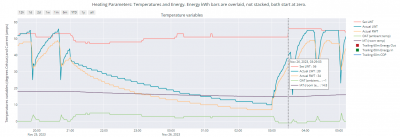Posted by: @mikeflI'm trying to get decent data out of my Grant Aerona over modbus too. Sadly, it also provides low resolution data; key values such as LWT and OAT are only provided to a resolution of 1°C, as (signed) integer values.
It's the same with Midea, most of the values are integers. I have just taken a pragmatic view that that will have to be good enough, and it is certainly far far better than nothing. As the charts I have posted show, you can get a lot of information from of integer based data.
@derek-m - yes, I agree, very likely.
Midea 14kW (for now...) ASHP heating both building and DHW
Posted by: @cathoderayPosted by: @mikeflI'm trying to get decent data out of my Grant Aerona over modbus too. Sadly, it also provides low resolution data; key values such as LWT and OAT are only provided to a resolution of 1°C, as (signed) integer values.
It's the same with Midea, most of the values are integers. I have just taken a pragmatic view that that will have to be good enough, and it is certainly far far better than nothing. As the charts I have posted show, you can get a lot of information from of integer based data.
@derek-m - yes, I agree, very likely.
Running the heat pump constantly at lower LWT, should help reduce the cycling and defrosting, until you can do something to alleviate the 'cold well' problem.
@derek-m - I'm going to turn off the setback as from tonight, and will try a period of fixed LWT starting tomorrow morning, and will monitor what happens. I think the main problem is going to be that I become in effect a human WCC - I'll be constantly changing the fixed LWT to maintain a steady IAT, unless I use the room stat to control the on/off behaviour of the heat pump. That will then cause another variation of cycling, on/off as dictated by the room stat...
Midea 14kW (for now...) ASHP heating both building and DHW
Posted by: @cathoderay@derek-m - I'm going to turn off the setback as from tonight, and will try a period of fixed LWT starting tomorrow morning, and will monitor what happens. I think the main problem is going to be that I become in effect a human WCC - I'll be constantly changing the fixed LWT to maintain a steady IAT, unless I use the room stat to control the on/off behaviour of the heat pump. That will then cause another variation of cycling, on/off as dictated by the room stat...
What I am suggesting is to not have a setback, but keep your AA system, since this should automatically request the lowest LWT that meets demand whilst trying to maintain the desired IAT.
Posted by: @derek-mWhat I am suggesting is to not have a setback, but keep your AA system, since this should automatically request the lowest LWT that meets demand whilst trying to maintain the desired IAT.
I don't think the AA script will do anything, recall it changes the ends of the WCC, which by definition won't be in use if WCC is off because Fixed LWT is on. I could make another script that changes the Fixed Set LWT, but then that is a IATCC (IAT Compensation Curve)... Surely if the idea is to have a fixed LWT, then it should be fixed, and the modulation achieved by turning the heat pump on and off, ie run in traditional fossil fuel mode?
Midea 14kW (for now...) ASHP heating both building and DHW
Posted by: @cathoderayPosted by: @derek-mWhat I am suggesting is to not have a setback, but keep your AA system, since this should automatically request the lowest LWT that meets demand whilst trying to maintain the desired IAT.
I don't think the AA script will do anything, recall it changes the ends of the WCC, which by definition won't be in use if WCC is off because Fixed LWT is on. I could make another script that changes the Fixed Set LWT, but then that is a IATCC (IAT Compensation Curve)... Surely if the idea is to have a fixed LWT, then it should be fixed, and the modulation achieved by turning the heat pump on and off, ie run in traditional fossil fuel mode?
I may have suggested trying a fixed LWT for a period of time to stabilse the system, in a similar manner to switching a swinging industrial control system from automatic to manual control to stop the swing, prior to switching back to auto and fine tuning the control.
I suppose you have a choice, run the system with a fixed LWT and allow the IAT to vary, or run the system in WC mode (with or without AA) to try to keep IAT constant. The important thing is to have the heat pump operating constantly if possible, so that it then requires the lowest LWT to meet demand.
If you really wish to improve the heat pump performance at lower OAT, then you need to resolve the air flow issues around the heat pump.
If you still wish to have an independent OAT sensor, you could consider coating an MD02 with circuit board lacquer and then putting it within a suitable box for wall mounting.
Posted by: @derek-mThe important thing is to have the heat pump operating constantly if possible, so that it then requires the lowest LWT to meet demand.
Yes, the real problem is the cycling, even at OATs that should have a steady LWT. Below 5 degrees OAT it will defrost cycle, above a certain OAT it has to cycle to modulate output, but in the middle it should run steady. I do accept the logic of your cold well theory, but, from the photos I have seen, a good many installed heat pumps are in some sort of cold well, you rarely see a heat pump in the middle of an open garden! They almost invariably are backed by a wall, and the air behind the heat pump sucked into the heat pump will be replenished by air from the side of the heat pump, and some of that will be made up from the cooler exhaust air, unless there is a gale blowing. My own heat pump isn't that enclosed, the hedges are not dense and they are metres not feet away. The heat pump is also on a bit of a mound, and some cold air will drain away down the sides of the mound.
A major problem is we have a very small sample size (n=1 for Midea) - for all we know, all Midea heat pumps, maybe even most heat pumps, do a lot of cycling behind the scenes, whether in a cold well or not. My guess is that less than half a dozen people in total (and that includes me) have actually posted minute by minute data, which is needed to see cycling. From @kev-m's data, we know Ecodans (more accurately, his Ecodan) cycle(s), but less so.
I wonder does anyone else have minute by minute data/charts over long (hour/day) periods that they would be willing to post here on the forum?
Midea 14kW (for now...) ASHP heating both building and DHW
Posted by: @derek-mIf you still wish to have an independent OAT sensor, you could consider coating an MD02 with circuit board lacquer and then putting it within a suitable box for wall mounting.
I had considered something along these lines, but came to the conclusion that it needs a free flow of air to reflect the local air temp. It has 5V going into it, for all we know it could be a mini heater that keeps itself warm!
I was hoping to do the Met Office vs Midea comparison soon. As ever it is not straight forward, I have minute by minute data and can calculate hourly average and so on, the HA Met Office data is three hourly, and I don't know if that is a spot of average value - I hope/assume the latter. As you will know, merging ('side joining') data from two tables where the time intervals are different can be tricky, and having just looked at the underlying HA data, it is all over the place, not even regular time intervals. I think we'll have to put up with HA's History Explorer's version of events:
The ambient here isn't from modbus, it is from the code I added to the midea_ac_lan module to get the Midea 'byte_9' which almost certainly is the OAT as reported by Midea. The blip in the trace overnight on the 25th/26th Nov is because I didn't include code to handle signed integers (the modbus code does, negative OAT temps appear correctly in that data, and in the plotly charts I normally post). Most of the Midea values are with 2 degrees or often less of one or both of the Met Office values.
Midea 14kW (for now...) ASHP heating both building and DHW
Minute by minute actual OAT data is required so as to compare this to your Midea OAT data, averaged data is of no use.
The reason I am interested is to check if, as I suspect, the difference between Midea reported OAT and actual OAT increases as OAT falls and the heat pump works harder.
On today's temperature chart, the Midea OAT appears to rise by about 5C when the heat pump is stopped at the start of a setback, then more importantly, when then heat pump restarts, the Midea OAT falls by about 4C, and since this OAT value is used by the controller to calculate the required LWT, the heat pump probably starts at maximum output.
I suspect, though may be wrong, that the difference between actual OAT and Midea OAT may vary with how hard the heat pump is working. At lighter loading the difference may be smaller, getting more pronounced as the heat pump works harder, and just making the underlying problem worse.
Posted by: @derek-mMinute by minute actual OAT data is required so as to compare this to your Midea OAT data, averaged data is of no use.
I thought the intention with the Met office data was to verify the accuracy or otherwise of the Midea OAT, and if it passed muster then it could be accepted as a reliable proxy for the wider local OAT, sorry.
Posted by: @derek-mOn today's temperature chart, the Midea OAT appears to rise by about 5C when the heat pump is stopped at the start of a setback, then more importantly, when then heat pump restarts, the Midea OAT falls by about 4C, and since this OAT value is used by the controller to calculate the required LWT, the heat pump probably starts at maximum output.
I think that, and all the other similar changes when the heat pump goes on of off, does confirm that, when running, the heat pump cools down its own input. As I mentioned before, you can feel the air is cooler when standing by a running heat pump. Her'es is a zoom in on the night before last's setback:
Here, at the start of and during the setback the Set LWT responds to changes in the OAT as expected (it seems it gets set, even if the heat pump is off). The curious period is at the end of the setback, when the OAT falls quickly, but the Set LWT stays the same for a full 30 mins after the restart, and then suddenly jumps up. The fact the previous changes in OAT are reflected in the Set LWT even when the changes are of short duration seems to suggests the setting interval is quite short.
Midea 14kW (for now...) ASHP heating both building and DHW
What is the 'source' of the Set LWT reading? Is it read from the Midea controller?
I wonder if the controller waits until the LWT has achieved a minimum value, before it makes any changes based upon the OAT sensor reading, when starting operation after a lengthy shutdown.
The 'effects' seen will always have an underlying 'cause'
- 26 Forums
- 2,356 Topics
- 53.4 K Posts
- 256 Online
- 6,017 Members
Join Us!
Worth Watching
Latest Posts
-
RE: Octopus Cosy Heat Pump Owners & Discussion Thread
@kevh with the Cosy 6 I know it definitely goes to arou...
By HarrisonC , 2 hours ago
-
RE: Setback savings - fact or fiction?
@cathoderay yes I am familiar with SQL. Interesting num...
By RobS , 3 hours ago
-

Parsnip, Bacon & Coconut Milk Soup
First let me say, I am only a cook because I am human a...
By Toodles , 3 hours ago
-

RE: Controlling Daikin Altherma via P1P2 and Home Assistant
@weoleyric Oh Dear, I don’t think I am going to be of m...
By Toodles , 4 hours ago
-
RE: Electricity price predictions
Ben Watts posted on LinkedIn that he had updated this w...
By Judith , 9 hours ago
-

RE: The good, the bad and the not that great – my heat pump installation
Small update, Emailed and Spoke to Midea UK and they ...
By Burtis , 9 hours ago
-
RE: Solis S6-EH1P8K-L-PLUS – Why I Chose It and What I’ve Learned So Far
@bash Octopus does charge for the admin. The process al...
By Batpred , 9 hours ago
-
RE: External pipework insulation
@transparent HI all The products you mention are ver...
By David Smith , 9 hours ago
-
RE: New Fogstar 15.5kWh upright solution
Issues still under investigation by Solis... Fogstar ...
By Batpred , 9 hours ago
-
RE: Who's your electricity provider and what's your tariff?
I agree, the consumer is not being properly represented...
By Batpred , 9 hours ago
-
RE: Advice on internal circulation pump noise
Thanks @mikefl - I'll maybe have a look at the lock-shi...
By jtg , 1 day ago
-

RE: Heat Pump Heats the House… But It’s Not Cosy. Emitter Changes or System Tweak?
@toodles interesting suggestion, thanks. I will try to...
By GrahamF , 1 day ago
-
RE: Mitsubishi Ecodan Auto Adaption trial to stop cycling.
The interval you talk of, i think, will be 60min for an...
By F1p , 1 day ago
-
Agree with @majordennisbloodnok on the setbacks. We hav...
By ChandyKris , 2 days ago
-

RE: Speedcomfort radiator fans
@deltona the way the links were added broke the page. A...
By Mars , 2 days ago
-

RE: Refrigerant R32, is it now banned in the EU from 1st Jan 2027 for monobloc ASHPs?
This has been delayed from what I believe to be this ye...
By dgclimatecontrol , 2 days ago
-
RE: Are We Sleepwalking Into Another Race to the Bottom?
this is why I provided current flow temperatures in the...
By ksim , 2 days ago
-

RE: Why Millions of UK Homes Struggle With Heat Pumps
There's many homes that would be quite a disruption for...
By dgclimatecontrol , 2 days ago
-
RE: Ecodan unable to hit legionella target temp - what's the consensus?
@rhh2348 ...maybe this option is what you want? Alter...
By benson , 2 days ago







